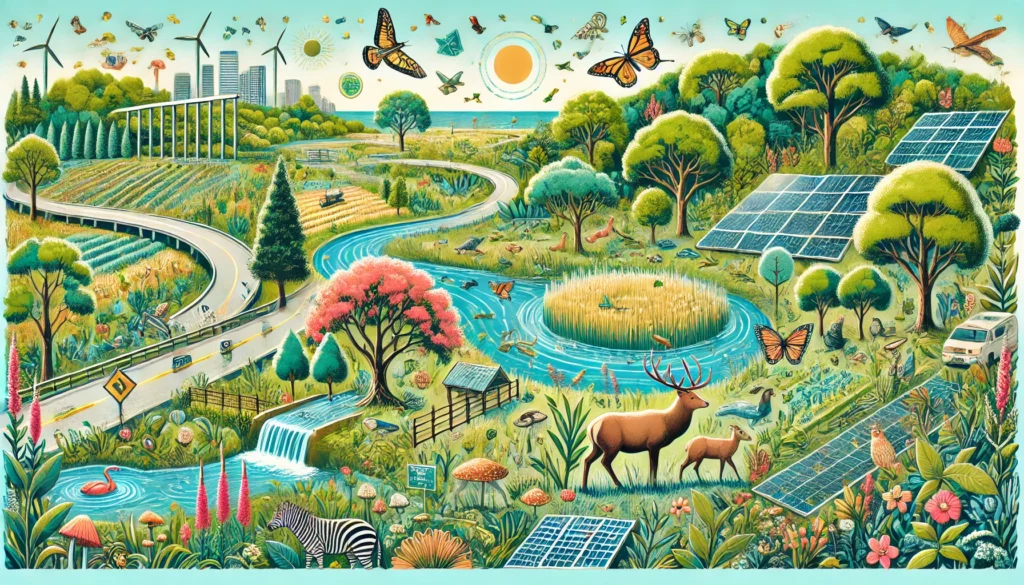Hey, Landowners!
When it comes to land development, it’s easy to get caught up in the excitement of building new homes, businesses, or recreational spaces. But have you ever thought about the importance of biodiversity on your land? Maintaining and enhancing biodiversity isn’t just about protecting wildlife; it’s a smart investment in your property’s long-term value and sustainability. Let’s explore why biodiversity matters in land development and how you can make it a key part of your project.
What is Biodiversity?
Why It’s Important: Biodiversity refers to the variety of life in a particular habitat or ecosystem. This includes everything from plants and animals to microorganisms and fungi. A healthy biodiversity means a robust ecosystem that can better withstand environmental changes, pests, and diseases, ultimately supporting more stable and productive land development.
The Benefits of Preserving Biodiversity
- Enhanced Property Value: Land with rich biodiversity often has a higher market value, especially if it includes features like mature trees, natural water sources, or thriving wildlife. These elements can make your property more attractive to buyers looking for a connection to nature, whether they’re purchasing a residential lot or a commercial space.
- Improved Ecosystem Services: Biodiverse ecosystems provide essential services such as pollination, water purification, soil fertility, and natural pest control. By preserving or enhancing biodiversity on your land, you’re investing in these natural benefits that can reduce maintenance costs and improve land quality over time.
- Regulatory Compliance and Incentives: In many regions, there are legal requirements to protect certain species or habitats during land development. Additionally, there may be financial incentives or grants available for projects that include biodiversity-friendly practices, helping to offset some development costs.
Key Challenges to Consider
- Balancing Development and Conservation: The main challenge in maintaining biodiversity during land development is finding the right balance. Development often involves clearing vegetation and altering natural habitats, which can negatively impact local species.
- Costs of Biodiversity-Friendly Development: Implementing biodiversity-friendly practices can sometimes increase upfront costs, such as incorporating green spaces, planting native species, or installing wildlife corridors. However, these costs are often balanced by long-term savings and increased property value.
- Navigating Regulations: Protecting biodiversity may involve adhering to specific regulations and guidelines, which can be complex. Working with environmental consultants can help you navigate these rules and ensure your project complies with local and federal laws.
Steps to Incorporate Biodiversity into Land Development
-
Conduct a Biodiversity Assessment: Before starting any development, hire an ecologist or environmental consultant to assess the existing biodiversity on your land. This assessment will help you understand what species and habitats are present and identify areas that need protection or enhancement.
-
Develop a Biodiversity Management Plan: Based on your assessment, create a plan that outlines how you’ll protect and enhance biodiversity during and after development. This could include preserving natural vegetation, creating green spaces, or installing features like bird boxes and pollinator gardens.
-
Use Native Plants in Landscaping: Native plants are adapted to your local climate and soil, requiring less water and maintenance. They also provide habitat and food for local wildlife, supporting biodiversity naturally.
-
Create Wildlife Corridors: If your land is large or situated near other natural areas, consider creating wildlife corridors that connect habitats. These corridors allow animals to move freely and safely across the landscape, promoting a healthy ecosystem.
-
Incorporate Green Infrastructure: Features like green roofs, rain gardens, and permeable pavements not only support biodiversity but also help manage stormwater and reduce environmental impact. These elements can enhance the aesthetic appeal of your development while providing functional benefits.
-
Monitor and Maintain Biodiversity: Biodiversity management doesn’t end once your development is complete. Regular monitoring and maintenance, such as managing invasive species and supporting habitat growth, are crucial to ensuring the long-term success of your efforts.
Maximizing the Benefits of Biodiversity
- Engage the Community: Community involvement can be a powerful tool in supporting biodiversity. Consider hosting volunteer events for tree planting or creating educational signage about local wildlife. Engaging the community not only fosters goodwill but can also provide additional support for your biodiversity initiatives.
- Market the Natural Appeal: Use your commitment to biodiversity as a selling point. Highlight the green spaces, wildlife habitats, and sustainable practices that make your development unique. Buyers and investors are increasingly looking for eco-friendly properties, and showcasing these features can set your development apart.
- Partner with Conservation Organizations: Collaborating with local conservation groups can provide valuable expertise and resources. These partnerships can help you implement best practices and even secure funding or recognition for your biodiversity efforts.
Wrapping It Up: Building with Nature in Mind
Incorporating biodiversity into your land development isn’t just about meeting regulations—it’s about creating a lasting, sustainable environment that benefits both people and wildlife. By taking steps to protect and enhance the natural elements of your property, you’re not only contributing to a healthier planet but also adding significant value to your development. Whether you’re building residential homes, commercial spaces, or something else entirely, making biodiversity a priority is a smart move for any landowner.

